
Macro-Jê is a medium-sized language family in South America, mostly in Brazil but also in the Chiquitanía region in Santa Cruz, Bolivia, as well as (formerly) in small parts of Argentina and Paraguay. It is centered on the Jê language family, with most other branches currently being single languages due to recent extinctions.
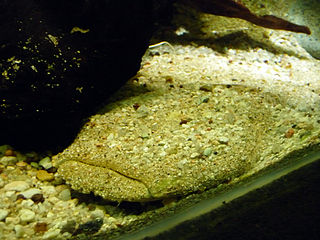
The Pseudopimelodidae are a small family of catfishes known as the bumblebee catfishes or dwarf marbled catfishes. Some of these fish are popular aquarium fish.
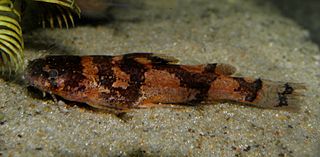
Microglanis is a genus of fish in the family Pseudopimelodidae native to South America. This genus has the widest distribution within its family, with species ranging from the Guianas to Venezuela; western slope of the Andes in Ecuador and Peru to the Río de La Plata basin in Argentina. They occur eastward to the Orinoco and Amazon basins. It is also present in the eastern coastal rivers of Brazil.
Hisonotus is a genus of armored catfishes native to South America. Species of Hisonotus and Curculionichthys are the only representatives of the subfamily Otothyrinae having serrae on the posterior edge of the pectoral fin spine. These species are small fishes, generally found in small fast flowing streams, where they grasp to the branches and leaves of aquatic or subaquatic plants. The species of this genus mostly occur in Atlantic coastal streams of southern Brazil and the Paraguay-Paraná system of southern South America. They are also distributed in the Río de La Plata basin and coastal rivers of southeastern Brazil.
Microlepidogaster is a genus of armored catfishes native to South America.
Pseudotothyris is a genus of armored catfishes native to South America.

Parotocinclus is a genus of fish in the family Loricariidae native to South America. This genus is distributed through almost all hydrographic systems in South America from the Guyana Shield drainages and Amazon Shield tributaries to the coastal drainages of eastern and southeastern Brazil, including the rio São Francisco basin. Most species have the caudal peduncle oval in cross section. It has been found that Characidium species may interact with P. maculicauda. The small Characidium will follow grazing P. maculicauda, which release particulate matter dislodged from the catfish's foraging.

Proceratophrys is a genus of frogs in the family Odontophrynidae. They are found in eastern and southern Brazil, northeastern Argentina, and Paraguay, possibly into Bolivia adjacent to the Brazilian border.
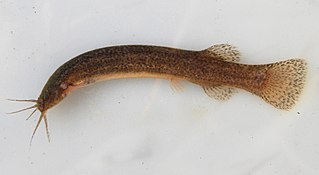
Ituglanis is a genus of small freshwater fish in the family Trichomycteridae native to South America. Their greatest diversity seems to occur in the Amazon River basin. Most species inhabit leaf litter, with several species living in caves.

Riograndia is an extinct genus of prozostrodontian cynodonts from the Late Triassic of Brazil. The type and only species is Riograndia guaibensis, named after the State of Rio Grande do Sul and Guaíba Basin, where it was discovered. Remains have been found in the Caturrita Formation of the geopark of Paleorrota. It was a small non-mammalian cynodont, with several advanced features also present in mammals. Several specimens of Riograndia guaibensis have been found in the towns of Candelária and Faxinal do Soturno in the Caturrita Formation. The genus defines the Riograndia Assemblage Zone.
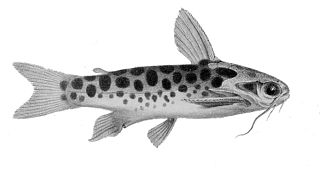
Tatia is a genus of small South American catfishes belonging to Auchenipteridae, the driftwood catfish family.
Centromochlus is a genus of fish in the family Auchenipteridae native to South America.

Characidium is a genus of fish in the family Crenuchidae. They are mainly found in South America, but C. marshi is from Panama. They are small, slender fish that live on the bottom in flowing fresh waters and feed on small animals such as insects.

Events in the year 1946 in Brazil.

The Constituent Cortes of 1820, formal title The General and Extraordinary Cortes of the Portuguese Nation, also frequently known as the Sovereign Congress or the Cortes Constituintes Vintistas, was the first modern Portuguese parliament. Created after the Liberal Revolution of 1820 to prepare a constitution for Portugal and its overseas territories, it used a different system from the traditional General Cortes for choosing representatives, and the three traditional feudal estates no longer sat separately. The Cortes sat between January 24, 1821 and November 4, 1822 at the Palácio das Necessidades in Lisbon. The work of the Constitutional Cortes culminated in the approval of the Portuguese Constitution of 1822.

Parapytanga is an extinct monotypic genus of temnospondyl, the type species being Parapytanga catarinensis. Parapytanga belongs to the family Rhinesuchidae. Fossils have been found in the Middle Permian Rio do Rasto Formation of Brazil.
Parotocinclus arandai is a species of catfish in the family Loricariidae. It is native to South America, where it occurs in tributaries of the Jucurucu River and the Buranhém River in Brazil. It is found in clear shallow waters with a depth of around 0.3 m (0.98 ft) and a substrate of sand or gravel. The species reaches 4.3 cm SL.
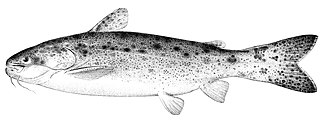
Glanidium ribeiroi is a species of driftwood catfish in the family Auchenipteridae. It is found in the Iguaçu River basin in South America.
Glanidium botocudo is a species of driftwood catfish in the family Auchenipteridae. It is found in coastal rivers systems, such as the Rio Doce and the Rio Mucuri in Brazil.













